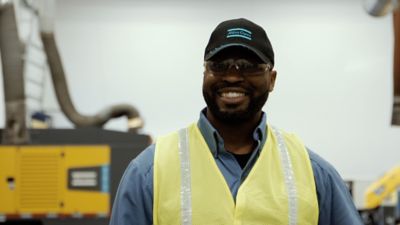How to find the right aeration blower
Reading time: 5 minutes
Picking the right type of aeration blowers for your wastewater treatment plant is not only extremely important but also a major challenge. That is why we have put together a few guidelines. The goal is to help you find the optimal aeration blowers for your specific requirements by giving you an idea of which questions to ask and which information to have available when you speak to your compressed air partner.
Many options, many challenges
First of all, there is some good news and some less good news when it comes to choosing the optimal aeration blower: There are many different products available to you, each with different pros and cons, which means that you will very likely find one that meets your needs.
But this wealth of options can also be a challenge to navigate, especially because the stakes are high. Your installation has to be able to deliver the right amount of compressed air so you can meet the purification standards.
To make that happen, the first thing to look at is the aeration blower’s size. There are a few parameters to consider.
Working pressure
Your working pressure is mainly determined by the depth of the tank. The deeper the tank, the higher the air pressure your system needs, will be. It affects what type of aeration blower technology is right for you. The higher the pressure, the more potential there is for energy savings.
Many plants opt for oil-free rotary lobe blowers. At very low pressures up to 0.3 bar(g), there is not that much efficiency to be gained. So in terms of efficiency and investment cost, they could be the right choice for your plant.
At higher pressures, however, your choices become less limited and you could pick a more energy-efficient type of blower. Even at an increase to, for example, 0.8 bar(g), the difference in energy consumption between, for instance, screw and lobe technology can be as high as 30%.
Flow capacity
The design flow capacity is another important factor. It is primarily determined by the size of your plant. If a blower cannot reach the required demand, you will not be able to treat all of your wastewater. Generally, the higher the flow, the bigger the potential savings. Lobe blowers, for example, are the preferred solution for smaller flows while turbo blowers are equipped to handle larger flows (and therefore larger wastewater plants).
Turndown capacity
A blower’s ability to regulate the air volume is an important parameter when you’re dealing with variable air demand. Because most treatment plants see so many fluctuations in demand throughout the year and even throughout the day, it is very important that the aeration blower can react to these swings.
Some blowers are better able to deal with these fluctuating flows. Blowers prepared for Variable Speed Drive (VSD) operation are always a good choice. You can opt to use your own, external VSD or choose a unit with integrated VSD. Lobe, screw, and magnetic bearing units are the best choices in terms of technology, as they have higher turndown capacity compared to other technologies.
Blower package
Do you prefer a plug & play package or do you want to put together your own solution? They both have their advantages and disadvantages.
A true plug & play solution will simplify installation and allow you to immediately start up for operation. Keep in mind that every blower manufacturer has its own definition of a complete package. For example, an air inlet filter for process air is an indispensable item. If you decide that a unit with turbo technology is right for you, you’ll need a blow-off silencer. These are all components you need before you can start operation but some brands do not include these in their standard packages.
On the other hand, some items can be reused which means you don’t need to repurchase them. Your existing check valve or an air outlet compensator, for instance, could be reused. Adding them to the package will only increase your investment cost.
Site matters
Another set of variables is connected to your specific site requirements. That not only means your facility but also the ambient conditions, all of which can impact the selection of the ideal compressed air solution.
New site or existing installation
If you’re looking for a replacement, you may be working with a fixed compressor room that cannot be expanded. This offers a lot less flexibility when it comes to the physical number of units and dimensions of the blowers. You may also already have a separate frequency converter installed. Now, however, many blowers have one that is already integrated, so you have to figure out which option you prefer.
On one hand, investing in blowers that have an integrated VSD will simplify installation (less programming and electrical work) and allow you to better control the units. On top of that, you’ll be able to get more out of your units, as they will have a wider flow reach with a higher turndown. On the other hand, the investment cost for these types of units is slightly higher (compared to units prepared for VSD).
Number of running hours
Similarly, the running hours of the different processes and the number of times the blowers have to start and stop also play an important role. Some processes are running continuously all year. In that case efficiency, and long service intervals are extremely important.
Others are only operating part of the day. Some units are simply not designed to deal with frequent starts and stops. Technologies such as lobe, screw or high-speed magnetic bearing are best suited for frequent starts and stops.
Noise limits
In residential areas, you’ll need to take into account the noise level of your equipment. Air blowers and compressors may be known as loud or noisy but they don’t have to be. With the design of a new unit, the noise level is taken into account. It is usually measured, tested, and indicated in the specifications so that you’ll know which units would make good neighbors.
Site accessibility
And, if your facility is really remote, then reliable access to service and maintenance should also be considered. In that case, it would be particularly important to choose a blower that is easy to maintain and has long service intervals.
Outdoor installation
Your choice of equipment will also depend on whether the blowers will be installed outdoors close to the point of use or indoors. Obviously, if your blowers are placed outdoors, robustness is a key requirement. But frost, extreme heat, rain, or all of the above mean your unit will require extra protection. A winterization kit or outdoor canopy is usually an optional feature.
Back-up installation
Another consideration is your wastewater treatment plant’s backup requirements. Here, it is important to think in terms of the operational and backup capacity you need and not in terms of the number of blowers: you might be able to replace your existing installation with fewer blowers that can deliver you the same (backup) capacity.
Aeration system control
An integrated controller is a great way to monitor the running conditions of your units and auto-receive alerts to your phone or via your SCADA system. The right controller can greatly improve the reliability of your blowers with predictive and preventive maintenance options.
If you’re replacing a group of blowers, it might be time to upgrade to a more advanced, central control system. A central controller is easy to install and program, as it greatly reduces the complexity that comes with programming your PLC. It also ensures one or multiple units are always running in the most efficient way.
Why the easy way of choosing an aeration blower is usually wrong
Replacing your existing blower by just looking at the data plate would mean you’ll miss out on a lot of potential efficiency or reliability gains. By gathering the information mentioned above, you’ll be well prepared to compare the different offers on the market in terms of compatibility with your process.
Once you’ve done that, you can start looking at other important factors such as the financial side of things. Do you want to keep your initial investment costs low but pay more for energy later on? Or is the total cost of ownership, i.e. energy savings later on, more important to you? Depending on what the answer is, a different solution may be the optimal one.
Your checklist for comparing solutions:
- Working pressure
- Flow capacity
- Turndown capacity
- Dimensions of the unit
- Service intervals
- Outdoor options (if needed)
- Package and ancillaries: what is included?



